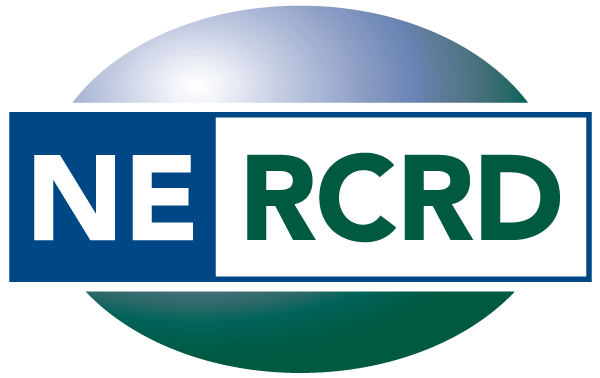Publications
A collection of all publications authored or co-authored by Center staff and/or partners. This collection is a work in progress—if you don’t find a publication you’re looking for, please search for it, or email us at nercrd@psu.edu.
Publications by type:
Publications by topic:
2018 Annual Report
This report summarizes annual accomplishments and activities at the Northeast Regional Center for Rural Development.
Authors: Northeast Regional Center for Rural Development
Date Published: February 1, 2019
View Publication
Excess Competition among Food Hubs
Food hubs offer a novel solution to connect small and mid-sized local farms, which individually
lack the scale to profitably market their products. Because many food hubs rely on grants and
philanthropy to provide services and are not necessarily profit-driven, markets may unintentionally
oversaturate due to overinvestment. We use a firm-entry model to estimate the average U.S. county
population necessary for one, two, and three food hubs to break even. Our findings suggest
that policy makers and philanthropists need to consider the carrying capacity of the local food
environment and population prior to supporting additional food hubs.
Authors: Rebecca Cleary, Stephan J. Goetz, Dawn Thilmany McFadden, Houtian Ge
Publication: Journal of Agricultural and Resource Economics Date Published: January 1, 2019
View Publication
Health Insurance and National Farm Policy
In the midst of national healthcare debates, there has been little discussion of how health, healthcare costs and access, and health insurance fit into national agriculture policy efforts to build a more vibrant and resilient farm economy. Yet Inwood (2015) found that 65% of commercial farmers identified the cost of health insurance as the most serious threat to their farm, more significant than the cost of land, inputs, market conditions, or development pressure. In order to grow the next generation of farmers and increase rural prosperity, there is a need to understand how healthcare costs, access, and insurance affect both agriculture and rural development.
Authors: Shoshanah Inwood, Alana Knudson, Florence A. Becot, Bonnie Braun, Stephan J. Goetz, Jane M. Kolodinsky, Scott Loveridge, Katlyn Morris, Jason Parker, Bob Parsons, Rachel Welborn, Don E. Albrecht
Publication: Choices Date Published: March 1, 2018
View Publication
2017 Annual Report
This report summarizes annual accomplishments and activities at the Northeast Regional Center for Rural Development.
Authors: Northeast Regional Center for Rural Development
Date Published: February 1, 2018
View Publication
2016 Annual Report
This report summarizes annual accomplishments and activities at the Northeast Regional Center for Rural Development.
Authors: Northeast Regional Center for Rural Development
Date Published: February 1, 2017
View Publication
The Impact Indicators Tips Booklet
A 38-page document written by George Morse, Charles French, and Scott Chazdon that explores practical and credible methods for using the "but for" rule to document Extension Community Development Impacts. A four-page introduction to the booklet is also available.
Authors: George Morse, Charlie French, Scott Chazdon
Publication: Published by NERCRD Date Published: October 17, 2016
View Publication
State-Level Cooperative Extension Spending and Farmer Exits
Abstract: Numerous studies have evaluated the impact of Extension on farm productivity and related outcomes. Here we use annual data from 1983 to 2010 covering the 50 U.S. states to examine the impact of Extension on net changes in the number of farmers. The historical transition of farmers out of U.S. agriculture raises the question of whether Cooperative Extension and underlying Hatch-funded research spending keeps farmers in agriculture or accelerates their exit. On balance, nearly 500,000 more farmers left than entered agriculture over the period studied. We estimate that without Extension, as many as 137,700 (or 28%) additional farmers would have disappeared on net. Overall, Extension programs are a remarkably cost effective way of keeping farmers in agriculture. Alternatively, shifting just 1.5% of federal farm program payments to Extension would have reduced net exits over this period by an estimated 11%, or 55,000 farmers.
A related infographic (below) was developed to help share the findings of this research.
Authors: Stephan J. Goetz and Meri Davlasheridze
Publication: Applied Economic Perspectives and Policy Date Published: April 19, 2016
Tags: Extension, impact
View Publication
The interactive effects of human capital and quality of life on economic growth
To bridge the gap in the quality of life (QOL) and economic growth literature and understand the reinforcing effects of QOL and human capital on economic development, we examine the interactive effects of these two factors on wage growth from 2000 to 2007 at the county level across the United States. First, a Rosen–Roback model is employed to estimate implicit values of amenities including climate, clean air and other natural attributes, which are used to generate QOL indices. Second, QOL, human capital represented by the share of college graduates, and their interaction serve as key variables in the wage growth model. An instrumental variable approach and location fixed effects are used to address endogeneity of human capital and control for location-specific unobservable characteristics. Results suggest that human capital and QOL significantly contribute to economic growth and the growth effects are even larger in nonmetropolitan counties. Importantly, we find that the effect of human capital on growth is larger in high-QOL counties and QOL enhances the effect of human capital on growth. Our results provide empirical support for community development strategies through providing utility-enhancing amenities that improve QOL and retain human capital.
Authors: Qin Fan, Stephan J. Goetz, Jiaochen Liang
Publication: Applied Economics Date Published: March 19, 2016
View Publication
2015 Annual Report
This report summarizes annual accomplishments and activities at the Northeast Regional Center for Rural Development.
Authors: Northeast Regional Center for Rural Development
Date Published: February 1, 2016
View Publication
